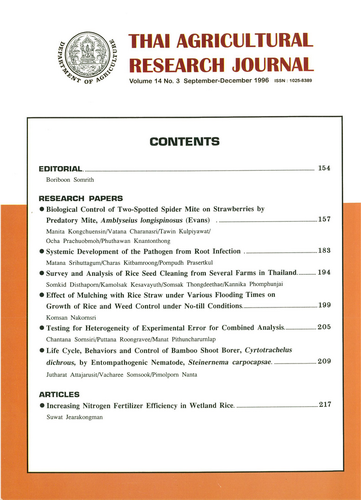Biological Control of Two-Spotted Spider Mite on Strawberries by Predatory Mite, Amblyseius longispinosus (Evans)
DOI:
https://doi.org/10.14456/thaidoa-agres.1996.17Keywords:
predatory mite, release rateAbstract
The extent to which the predatory mite, Amblyseius longispluosus (Evans), can control the two-spotted spider mite, Tetranychus urticae Koch in strawberries was investigated. Trials were conducted on strawberry plots in Chiang Mai during 1993-1996. Mass rearing of A. longsispinosus for the release purpose was carried out on mungbean, the best host plant as well as cowpea, infested with mulberry red mites (T. truncatus Ehara) in greenhouse. The initial predator: red mite rations were found to be between 1 : 20 to 1:50, in order to build up the population of A. longispinosus.rnIn 1994, the optimal release rate of A. longispinosus was established. Three rates were investigated 2, 5 and 10 mites per plant. The release was started when T. urticeae were found about 5 mites per leaflet. The result indicated that the two-spotted spider mite populations was significantly reduced in 3 release plots within 4 weeks after 2 times releasing. The mean nymbers of T. urticae in the 3 release plots were significantly different from the check (no release), but not different from each other. The results indicate that the suitable releasing rate of A. longispinonsus should be at 2-5 mites per plant.rnThe ability of A. longispinosus was made at 2-week-interval at the rates of 2-5 mites per plant for 7 weeks. Population of T. urticae and A. longispinosus were followed at 2-week-intervals thoughout the study. T. urticae was effectively suppressed by A. longispinosus with the pest population reaching a peak of 172.64 mites per leaftet in the check, but only 57-86 mites per leaflet in the release plots. The difference in the overall spider mite population between check and release plots were statistically significant. The pest population was completely controlled within 12 weeks. The inflorescence numbers of the strawberry in release plots was significantly different from those in the check, and as result, the yield from the release plot was estimated to be 102.62 kg of fruit per 400 m2 higher than that of the non-release.
Downloads
Published
How to Cite
Issue
Section
License

This work is licensed under a Creative Commons Attribution-NonCommercial-NoDerivatives 4.0 International License.
Thai Agricultural Research Journal



